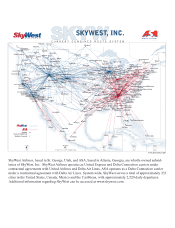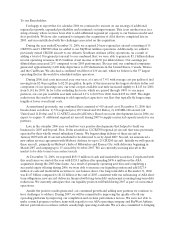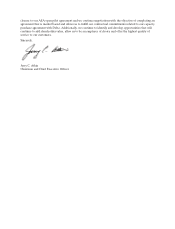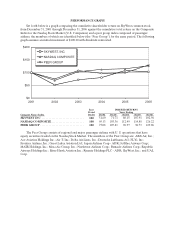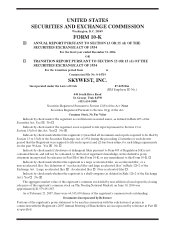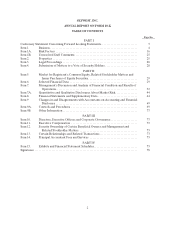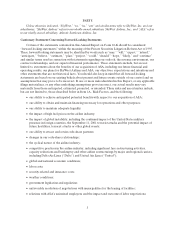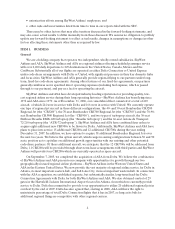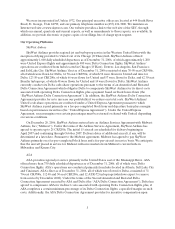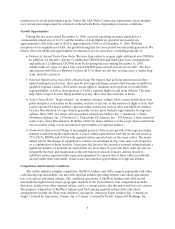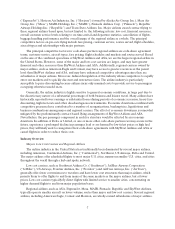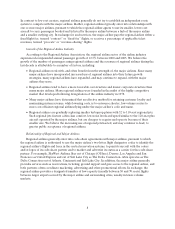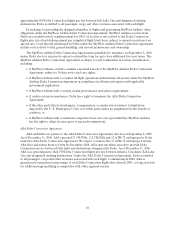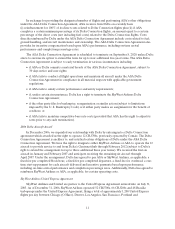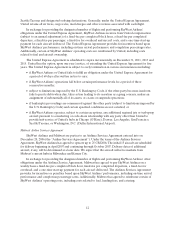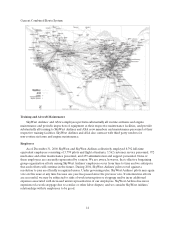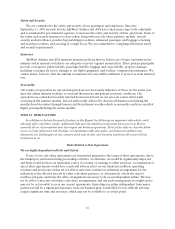SkyWest Airlines 2006 Annual Report Download - page 12
Download and view the complete annual report
Please find page 12 of the 2006 SkyWest Airlines annual report below. You can navigate through the pages in the report by either clicking on the pages listed below, or by using the keyword search tool below to find specific information within the annual report.6
satisfaction of certain performance goals. Under the ASA DeltaConnection Agreement, excess margins
overcertain percentages must be returned or shared with Delta, depending on various conditions.
Growth Opportunities
During the five years ended December 31,2006,our total operatingrevenues expanded at a
compounded annual rate of 41.6% and the number of daily flights we operated increased from
approximately1,000 at the end of 2002 to approximately2,400 as of December 31, 2006. With the
exception of ouracquisition of ASA, our growth during that five-year periodwas internally generated. We
believethereare additional opportunities for expansion of our operations, consistingprimarily of:
•DeliveryofAircraftUnder Firm Order. We have firm orders to acquire eight additional new CRJ900s.
In addition, we intend to operate 11 additionalCRJ200s through third-party lease arrangements
and sublease 12 additional CRJ700s from Delta during the year ending December 31, 2007.
Additionally, we expect to place four owned CRJ200 spare aircraft into service in 2007. We have
agreements with Delta or Midwesttoplaceall 35 of theseaircraft into revenue service, under long-
term, fixed-fee contracts.
•PotentialOpportunities from Delta’s Restructuring. We believe that as Delta restructures its fleet
under bankruptcy protection, there may be newregional flying contracts that become available for
qualified regional carriers. ASA holds certainrights to maintain its proportion of overall Delta
regional flights, as well as its proportion of Delta’s regionalflights to and from Atlanta. This may
help ASA competefor newflying mandates, if any, that come into existence at Delta.
•Scope Clause Relief. “Scope clauses” areelements of major airlines’ labor contracts with their own
pilots that placerestrictionsonthe number and size of aircraft, or the amount of flight activity, that
canbe operated by major airlines’ regional airline contractors such as ASA and SkyWest Airlines.
Greater liberalization of scope clauses generallycreates more business opportunities forregional
airlines. Since 2001, five major national airlines (American Airlines, Inc. (“American”), Delta,
Northwest Airlines, Inc. (“Northwest”), United andUSAirways, Inc.“US Airways”)have achieved
some scope clause liberalization. If further efforts by majorairlines to relaxscope clause restrictions
are successful, it may create incremental opportunities forregional airlines.
•Narrowbody Replacement Flying. Ameaningfulportion of therecent growth of the regional airline
industry resulted from thereplacement of major airline-operated narrowbody jet aircraft (such as
737s, DC9s, MD80s andA319s) with regional airline-operated jets on the same routes. The major
airline affects this change in equipment to achieve an advantage in trip costs, unit costs, frequency
or acombination of these benefits. At present, the fleets of thesix majornational airlines include a
significant number of narrowbody aircraft that aremore than 15 yearsold. Such older aircraft are
frequently less fuel-and maintenance-efficient than new aircraft. If major airlines decide to
substitute newer regional airline-operatedequipment for anyportionof these older narrowbody
aircraft under their retirement, it may create incremental opportunities for regional airlines.
Competition and Economic Conditions
Theairline industry is highly competitive.SkyWestAirlines and ASA compete principally with other
code-sharing regional airlines,but also with regional airlines operatingwithout code-share agreements,
low-costcarriersand major airlines. The combined operations of SkyWest Airlines and ASA extend
nationally throughout most major geographic markets in the United States. Our competition includes,
therefore, nearly every other regionalairline, and to a certain extent, also the major and low-cost carriers.
Theprimary competitors of SkyWest Airlines and ASAamong regional airlines with code-share
arrangements include Air Wisconsin Airlines Corporation, American Eagle Airlines, Inc. (“American
Eagle”)(owned by American), Comair, Inc. (“Comair”)(owned by Delta), ExpressJetHoldings, Inc.


